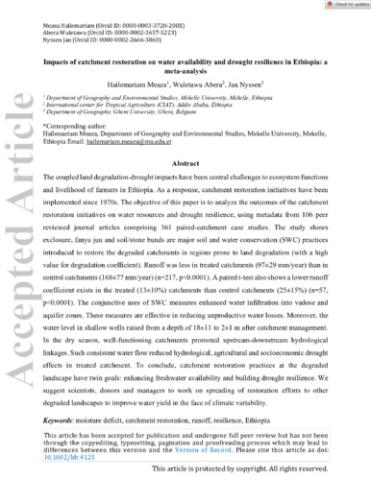Abstract
The coupled land degradation‐drought impacts have been central challenges to ecosystem functioning and livelihood of farmers in Ethiopia. As a response, catchment restoration initiatives have been implemented since the 1970s. The objective of this article is to analyze the effects of such catchment restoration initiatives on water resources and drought resilience, using metadata from 106 peer‐reviewed journal articles comprising 361 paired‐catchment case‐studies. The study shows exclosures, fanya juu (ditches with embankments along the contour), and soil or stone bunds are the major soil and water conservation (SWC) practices implemented to restore degraded catchments in regions prone to land degradation (with a high value for Fournier's degradation coefficient). Runoff depth was less in the treated catchments (97 ± 29 mm yr‐1) than in the control catchments (168 ± 77) mm yr‐1 (n = 217, p 0.0001). A paired t‐test also shows lower runoff coefficients in the treated (13 ± 10%) catchments than in the control catchments (25 ± 15%) (n = 57, p 0.0001). The conjunctive use of SWC measures enhanced water infiltration into the vadose and aquifer zones. These measures are effective in reducing unproductive water losses. Moreover, the water level in shallow wells raised from a depth of 18 ± 11 to 2 ± 1 m after catchment management. In the dry season, well‐functioning catchments promoted upstream‐downstream hydrological linkages. The resulting base flow reduced hydrological, agricultural, and socioeconomic drought effects in the treated catchments. To conclude, catchment restoration practices in degraded landscapes have twin goals: enhancing freshwater availability and building drought resilience. We suggest scientists, donors, and managers to work on spreading restoration efforts to other degraded landscapes to improve water yield in the face of climate variability.

